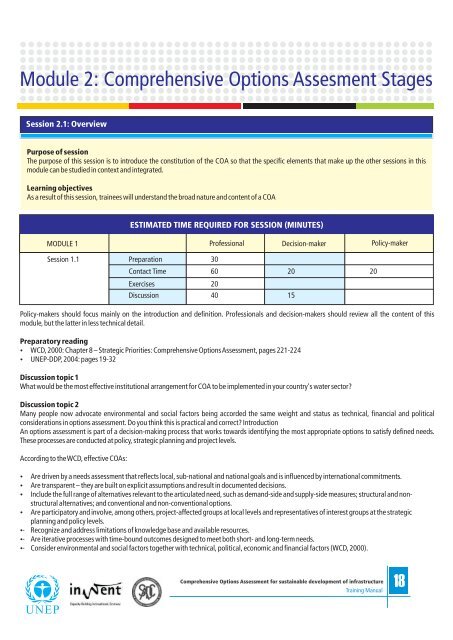Comprehensive Option Assesment - UNEP
Comprehensive Option Assesment - UNEP
Comprehensive Option Assesment - UNEP
You also want an ePaper? Increase the reach of your titles
YUMPU automatically turns print PDFs into web optimized ePapers that Google loves.
Module 2: <strong>Comprehensive</strong> <strong>Option</strong>s <strong>Assesment</strong> Stages<br />
Session 2.1: Overview<br />
Purpose of session<br />
The purpose of this session is to introduce the constitution of the COA so that the specific elements that make up the other sessions in this<br />
module can be studied in context and integrated.<br />
Learning objectives<br />
As a result of this session, trainees will understand the broad nature and content of a COA<br />
ESTIMATED TIME REQUIRED FOR SESSION (MINUTES)<br />
MODULE 1 Professional Decision-maker Policy-maker<br />
Session 1.1<br />
Preparation<br />
30<br />
Contact Time<br />
60<br />
20<br />
20<br />
Exercises<br />
20<br />
Discussion<br />
40<br />
15<br />
Policy-makers should focus mainly on the introduction and definition. Professionals and decision-makers should review all the content of this<br />
module, but the latter in less technical detail.<br />
Preparatory reading<br />
WCD, 2000: Chapter 8 – Strategic Priorities: <strong>Comprehensive</strong> <strong>Option</strong>s Assessment, pages 221-224<br />
<strong>UNEP</strong>-DDP, 2004: pages 19-32<br />
Discussion topic 1<br />
What would be the most effective institutional arrangement for COA to be implemented in your country's water sector?<br />
Discussion topic 2<br />
Many people now advocate environmental and social factors being accorded the same weight and status as technical, financial and political<br />
considerations in options assessment. Do you think this is practical and correct? Introduction<br />
An options assessment is part of a decision-making process that works towards identifying the most appropriate options to satisfy defined needs.<br />
These processes are conducted at policy, strategic planning and project levels.<br />
According to the WCD, effective COAs:<br />
Are driven by a needs assessment that reflects local, sub-national and national goals and is influenced by international commitments.<br />
Are transparent – they are built on explicit assumptions and result in documented decisions.<br />
Include the full range of alternatives relevant to the articulated need, such as demand-side and supply-side measures; structural and nonstructural<br />
alternatives; and conventional and non-conventional options.<br />
Are participatory and involve, among others, project-affected groups at local levels and representatives of interest groups at the strategic<br />
planning and policy levels.<br />
· Recognize and address limitations of knowledge base and available resources.<br />
· Are iterative processes with time-bound outcomes designed to meet both short- and long-term needs.<br />
· Consider environmental and social factors together with technical, political, economic and financial factors (WCD, 2000).<br />
<strong>Comprehensive</strong> <strong>Option</strong>s Assessment for sustainable development of infrastructure<br />
Training Manual<br />
18
















